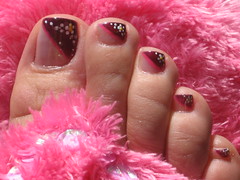
Photo by Rachel D
I enjoyed hanging out online in my slippers. I think the idea of learning anytime anywhere is awesome. The part that was missing for me is the face-t0-face discussion with my colleagues afterwards. I would love to be able to sit down and hash out how to implement some of the ideas.
I attended the 2007 online session titled “Design Matters” by Dean Shareski. He emphasizes the importance of design in everything we do. We are living in a world where design creates siginificance, setting apart media, tools, and even classrooms. The presentation is divided between a discussion of instructional design and multimedia design. He argues that designing a classroom around the paradigm of a “studio” environment will create possiblities for learning and change the roles of the teacher and student. He also proposes that in instructional design, follow the adage of “first do no harm” or “avoid doing violence to creativity”. He says we need to get away from a technical, rational approach to instructional design, and instead think as an innovator.
In multimedia design, Shareski advocates the direct instruction of planning, giving students a clear purpose for their projects. It does not matter which planning approach a student utilizes, as long as this stage in the creative process is emphasized. This allows the teacher, who may not even be technologically savvy, to immerse themselves in ensuring that students will create effective pieces with relevant content. Shareski also stresses the need for educators to directly teach visual literacy. Students need to understand the fundamentals of good photographic design, good video design, how to use PowerPoint as a visual tool (as opposed to a text tool), and how to consider using multiple vantage points.
Shareski compares learning the writing process to learning the visual design process. The one tenant of his philsophy where I diverge is in his thoughts about templates. He says that we should rid our instruction of templates, so that students can start with a white canvas, allowing for students to create the desire to “build significance” on their own. I argue as a writing teacher that students need a formula or roadmap, so that when they master the art form, they can then break the rules and do so with style, elegance, purpose, and significance. We all need to start somewhere–have a simple structure that we can go beyond is always a helpful learning tool. This is ONE way students learn to be effective writers, and I argue that in the creation of multimedia, beginners need a starting point. Of course, we all hope our students will go beyond our expectations and usually they do, even when they are set high.
Finally, one more thing I am taking away from this online session is to consider the 4-slide contest proposed by David Meyer for the Chicago Graduate School of Business application. I think this is a wonderful way to teach visual literacy, constraint, and the power of significance. This can tie into persuassion, memoir, and many other langauge arts related skills, not to mention visual literacy, of course. I would love to try this exercise with the faculty at my school. Take a look at the final entries!



